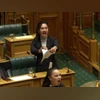On Thursday, November 14, New Zealand’s parliament was briefly suspended after a protest led by Māori Party MP Hana-Rawhiti Maipi-Clarke. The protest was in response to a controversial piece of legislation—the Treaty Principles Bill, which seeks to reinterpret the Treaty of Waitangi, an agreement between the British crown and the Māori people signed in 1840.
The Haka Protest
Maipi-Clarke, aged 22, led a haka, a traditional Māori ceremonial dance, in the parliamentary chamber. The haka was performed in response to her party’s stance on the Bill. She tore up a copy of the Bill in front of its author, further intensifying the protest. The protest gained momentum as MPs from the Māori, Green, and Labour parties, along with some individuals in the public gallery, joined in the haka.
Significance of the Haka
The haka holds deep cultural significance for the Māori people, representing strength, pride, and unity. Traditionally, it was performed by Māori warriors before battle or as a gesture of welcome. It involves chanting, dramatic facial expressions, hand movements, and stamping of feet. Haka performances are not limited to military contexts but also occur during funerals, celebrations, and significant events.
In 2019, the haka made headlines globally when students across New Zealand performed it in tribute to victims of the Christchurch shootings.
Types of Haka
There are different types of haka, each with its own purpose:
- War Haka: Performed before battle to intimidate the enemy.
- Short Haka: A lighter performance, aimed at uplifting the spirit.
- Welcoming Haka: Used during formal greetings.
- Manawa Wera: A haka performed at funerals to express grief.
The Treaty Principles Bill
The Treaty Principles Bill was introduced by David Seymour, the leader of the Act Party, a minor partner in New Zealand’s center-right coalition government. The Bill aims to amend the Treaty of Waitangi, a foundational document that established New Zealand’s relationship between the British Crown and Māori chiefs.
- Background of the Treaty of Waitangi: Signed in 1840, the Treaty promised the Māori tribes broad rights to their lands and interests in exchange for governance by the British Empire.
- The Bill’s Purpose: The Bill intends to define the principles of the Treaty legally, as the Treaty itself does not explicitly list them. Critics argue that this could undermine Māori rights.
Māori Perspectives and Opposition
Critics, including Māori rights groups and some coalition members, have expressed concerns that the Bill would undermine the Treaty’s significance. They argue that the Bill could threaten Māori rights and promote anti-Māori sentiments. A protest march, or hīkoi, spanning 1,000 kilometers from the North Island to the capital Wellington, is underway to oppose the Bill.
Parliament’s Response
Despite the protest and brief suspension of parliament, the first reading of the Bill passed. However, the future of the Bill remains uncertain as it faces opposition from various sectors of society, including from within the ruling coalition, such as Prime Minister Christopher Luxon, who called it “simplistic.”
Multiple-Choice Questions (MCQs):
- What prompted the suspension of New Zealand’s parliament on November 14, 2024?
- a) A debate on the Treaty of Waitangi
- b) A protest by Māori legislators led by a ceremonial haka
- c) A national security crisis
- d) A power outage in the parliament building
- What does the haka traditionally symbolize in Māori culture?
- a) A celebration of economic achievements
- b) Cultural pride, strength, and unity
- c) A call for political action
- d) A performance to entertain the audience
- Who introduced the Treaty Principles Bill?
- a) Prime Minister Christopher Luxon
- b) Hana-Rawhiti Maipi-Clarke
- c) David Seymour, leader of the Act Party
- d) A member of the Green Party
- What year was the Treaty of Waitangi signed?
- a) 1780
- b) 1840
- c) 1900
- d) 2000
- What is the purpose of the Treaty Principles Bill according to its proponents?
- a) To rewrite the Treaty of Waitangi
- b) To reinterpret the Treaty’s principles and define them legally
- c) To abolish the Treaty of Waitangi
- d) To eliminate the Māori language from official documents
- What is the significance of the haka performed during protests?
- a) It symbolizes victory in battle
- b) It is a way of showing resistance and unity against perceived injustice
- c) It is a form of entertainment
- d) It celebrates the signing of the Treaty of Waitangi
- Which of the following is a primary concern of critics regarding the Treaty Principles Bill?
- a) It could promote Māori rights
- b) It could threaten Māori rights and promote anti-Māori rhetoric
- c) It would allow the Māori language to be used in parliament
- d) It would create a new tribunal to address historical wrongs
)